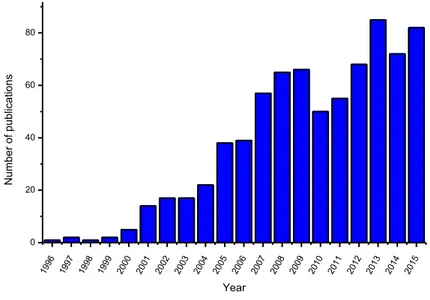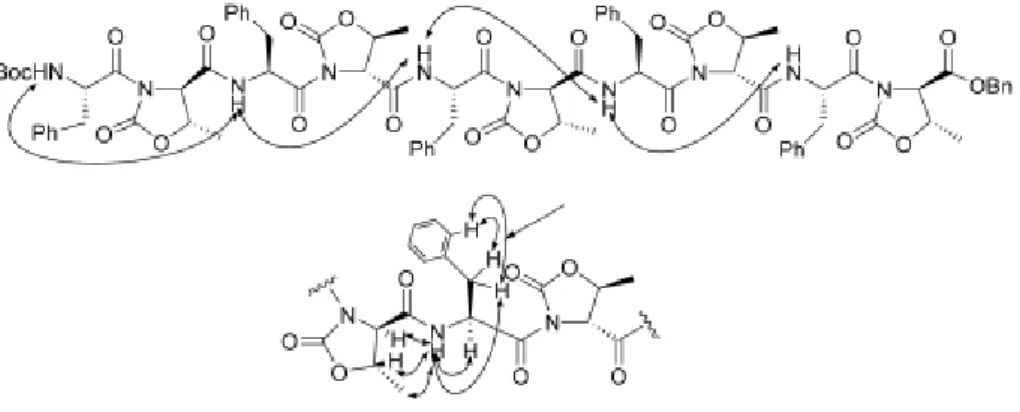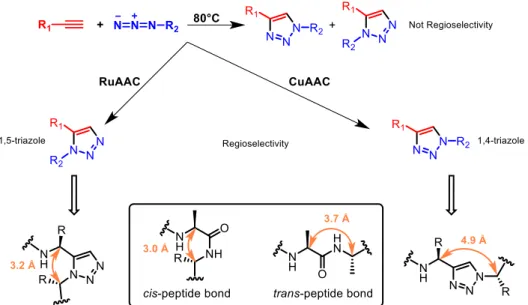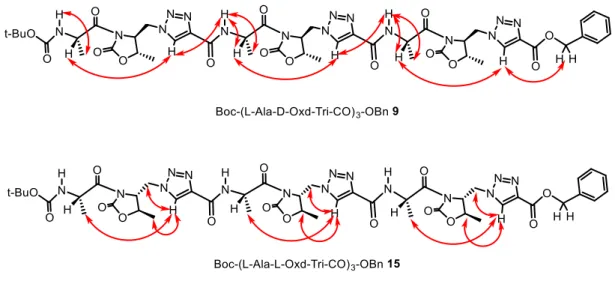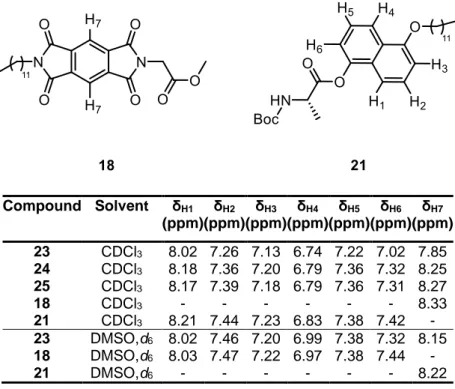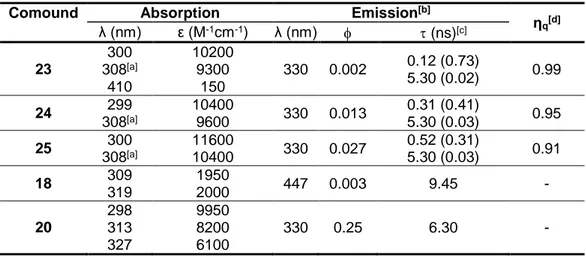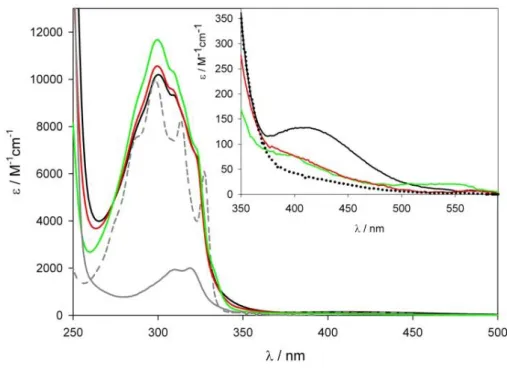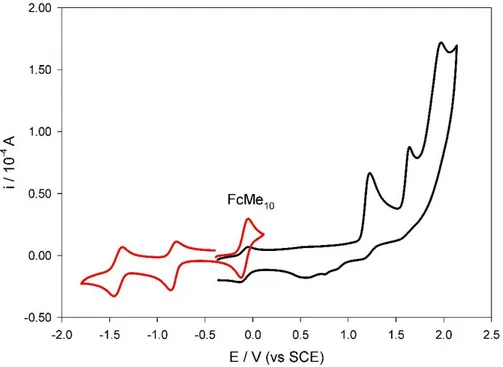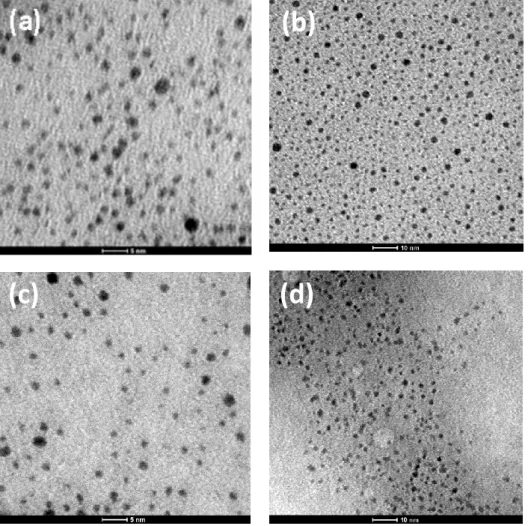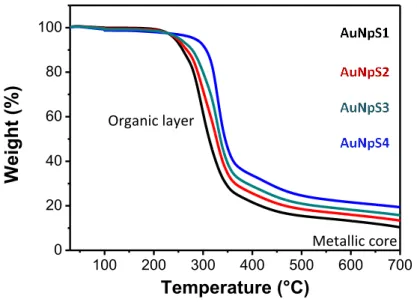Alma Mater Studiorum – Università di Bologna
DOTTORATO DI RICERCA IN
CHIMICA
Ciclo XXVIII
Settore Concorsuale di afferenza: 03/C1
Settore Scientifico disciplinare: CHIM/06
Preparation and Applications of Pseudopeptide-Based Nanomaterials
Presentata da: Lorenzo Milli
Coordinatore Dottorato
Relatore
Prof Aldo Roda
Prof.ssa Claudia Tomasini
Dott. Lorenzo Milli
Supervisore: Prof. Claudia Tomasini Curriculum: Scienze Chimiche Indirizzo: Chimica Organica
Titolo della tesi: Preparation and Applications of Pseudopeptide-Based Nanomaterials
During the three years of his PhD, Lorenzo Milli focused his research project on the synthesis, characterization and application of pseudopeptide foldamers.
During this period, he collaborated with my research group in the field of synthetic organic chemistry and he gained experience in all the techniques needed for the synthesis and analysis of organic molecules. Quickly he understood all the problems related to his research project that dealt with the preparation and application of new seudopeptides that behave as low molecular weight gelators. Moreover he prepared pseudopeptides capped with electrodonor and electroacceptor for energy transfer, then he made gold nanoparticles containing pseudopeptide foldamers and finally pseudopeptides capped with fluorescent tags. He is versatile and collaborative and he is able to find solution for problems, demonstrating excellent skills in organizing the work. Moreover he collaborates optimally with colleagues in the laboratory and other research groups involved in collaborative projects. The main results achieved during the period of his PhD are documented by 7 scientific articles published in important peer-reviewed international journals.
1) N. Castellucci, G. Falini, L. Milli, M. Monari, S. Abbate, G. Longhi, E. Castiglioni, G. Mazzeo, C. Tomasini – “Solid-State Properties and Vibrational Circular Dichroism Spectroscopy in Solution of Hybrid Foldamers Stereoisomeric Mixtures” ChemPlusChem, 2014, 79, 114–121.
2) L. Milli, M. Larocca, M. Tedesco, N. Castellucci, E. Ghibaudi, A. Cornia, M. Calvaresi, F. Zerbetto, C. Tomasini – “α,ε-Hybrid Foldamers with 1,2,3-Triazole Rings: Order versus Disorder”, Journal of Organic Chemistry, 2014, 79, 5958–5969.
3) L. Milli, N. Castellucci, C. Tomasini – “Turning Around the L-Phe-D-Oxd Moiety for a Versatile Low Molecular Weight Gelator”, Eur. J. Org. Chem., 2014, 5954–5961.
4) C. Tomasini, N. Castellucci, V. C. Caputo, L. Milli, G. Battistelli, S. Fermani, G. Falini – “Shaping calcite crystals by customized self-assembling pseudopeptide foldamers”, CrystEngComm, 2015, 17, 116–123.
5) L. Milli, E. Marchi, N. Castellucci, M. T. Indelli, M. Venturi, P. Ceroni, C. Tomasini – “Pseudopeptide Foldamers Designed for Photoinduced Intramolecular Electron Transfer”, RSC Advances, 2015, 5, 10809-10815.
6) R. Fanelli, L. Milli, A. Cornia, A. Moretto, N. Castellucci, N. Zanna, G. Malachin, R. Tavano, C. Tomasini – “Chiral Gold Nanoparticles Decorated with Pseudopeptides, Eur. J. Org. Chem., 2015, 6243-6248.
7) N. Zanna, A. Merlettini, G. Tatulli, L. Milli, M. L. Focarete, C. Tomasini - Hydrogelation Induced by Fmoc-Protected Peptidomimetics, Langmuir, 2015, 31, 12240-12250.
In addition, one manuscript has been submitted and three manuscripts are in preparation and will be soon submitted.
He has been the co-supervisor of two 2nd level degrees thesis in Chemistry and 4 1st level degree thesis
in Chemistry and 2 1st level degree thesis in Biological Sciences proving a great ability in coordination of
the activities of the students. He has also been tutor for the incoming students of the Scuola di Farmacia, Biotecnologie e Scienze Motorie for two years demonstrating great teaching skills.
He took actively part in 1 international congress and 2 national congress with oral or poster presentations showing excellent knowledge of the presented subjects, ability of organize the information in a slide presentation, and effective communication skills.
Moreover he attended the National School of Photochemistry in 2013 and the XL International Summer School on Organic Synthesis in 2015.
My overall evaluation of the Candidate is excellent.
The Board expresses a score of excellence on the activity carried out by the candidate during the whole cycle of doctorate and considers him worthy to attain the PhD in Chemistry.
i
Acronyms
2D Two Dimensional 3D Three Dimensional A Acceptor Ala AlanineAuNPs Gold Nanoparticles
Bn Benzyl
Boc tert-Butyloxycarbonyl
Carboxy-H2DCFDA 6-Carboxy-2’,7’-dichlorodihydrofluorescein diacetate
CD Circular Dichroism
CT Charge transfer
CuAAC Copper-Catalysed Azide Alkyne Cycloaddition
D Donor
DBU 1,8-Diazabicyclo[5.4.0]undec-7-ene
DCC N,N'-dicyclohexylcarbodiimide
DCM Dichloromethane
DFT Density Functional Theory
DIEA N,N-Diisopropylethylamine
DLS Dynamic Light Scattering
DMAP 4-Dimethylaminopyridine
DMF Dimetilformammide
ECD Electronic Circular Dichroism
ECM Extracellular Matrix
EDTA ethylenediaminetetraacetic acid disodium salt
ET Electron Transfer
EtOH Ethanol
EY Eosin Y
Fmoc 9-Fluorenylmethoxycarbonyl
FT-IR Fourier Transform – Infra Red
G' Storage Modulu G'’ Loss Modulu GdL glucono-δ-lactone Gly Glycine GO Graphene Oxide HATU 1-[Bis(dimethylamino)methylene]-1H-1,2,triazolo[4,5-b]pyridinium 3-oxid hexafluorophosphate HBTU N,N,N′,N′-Tetramethyl-O-(1H-benzotriazol-1-yl)iranium hexafluorophosphate
HeLa Henrietta Lacks
L Linker
LMWG low molecular weight gelator
LVE Linear Viscoelastic
MB Methylene Blue
MeOH Methanol
MTS
3-(4,5-dimethylthiazol-2-yl)-5-(3-carboxymethoxyphenyl)-2-(4-sulfophenyl)-2Htetrazolium
NMR Nuclear Magnetic Resonance
NOE Nuclear Overhauser Effect
NOESY Nuclear Overhauser Effect Spectroscopy
NPs Nanoparticles
Oxd 4-carboxy-5-methyl-oxazolidin-2-one
PAs Peptide amphiphiles
PBS Phosphate Buffered Saline
Pd/C Palladium on carbon
ii
p-Glu Pyroglutammic acid or 5-oxo-Proline
Ph Phenyl
Phe Phenylalanine
Pro Proline
ROESY Rotating frame nuclear Overhauser Effect Spectroscopy
ROS Reacting Oxygen Species
RuAAC Ruthenium-Catalysed Azide Alkyne Cycloaddition
SEM Scanning Electron Microscopy
tBu tert-Buthyl
TEA Triethylamine
TEM Transmission Electron Microscopy
TFA Trifluoroacetic acid
THF Tetrahydrofuran Thr Threonine Tri 1,2,3 Triazole Trp Tryptophan TsCl 4-Toluenesulfonyl chloride Tyr Tyrosine Val Valine
Xaa General Amino Acid
I
Summary
1.
Introduction... 1
1.1. Foldamers ... 1 1.1.1. Biotic Foldamers ... 5 1.1.1.1. Peptoids ... 5 1.1.1.2. β-Peptides ... 5 1.1.1.3. Alternating α/β-Peptides ... 6 1.1.1.4. γ-Peptide ... 7 1.1.1.5. Oligoureas ... 7 1.1.2. Abiotic Foldamers ... 71.1.2.1. Oligoarylamides and Oligoarylureas ... 8
1.1.2.2. Phenylene Ethylene ... 9
1.1.2.3. Oligoheterocyclic Strands ... 9
1.1.2.4. Aedamers ... 9
1.2. Pseudoproline Foldamers Based on 5-Carboxy-Oxazolidin-2-ones or Pyroglutamic Acids ... 11
2.
Base Studies ... 19
2.1. Conformational Studies ... 19
2.1.1. 1,2,3-Triazole as Peptidomimetics ... 19
2.1.2. Synthesis of the L-Oxd-Tri Scaffold and Preliminary Conformational Analysis... 21
2.1.3. Synthesis of α,ε-Hybrid Oligomers ... 23
2.1.4. Conformational Analysis ... 25
2.1.4.1. 1H NMR Spectroscopy ... 25
2.1.4.2. ECD Spectroscopy ... 27
2.1.4.3. Single-Crystal X-ray Diffraction ... 29
2.1.4.4. Molecular Dynamics ... 32 2.1.5. Complexation with Cu2+ ... 35 2.1.5.1. UV-Vis Spectroscopy ... 35 2.1.5.2. ECD Spectroscopy ... 36 2.1.5.3. EPR Spectroscopy ... 37
3.
Applications ... 39
3.1. Photochemistry and Photophysics ... 39
3.1.1. Supramolecular Photochemistry ... 39
3.1.2. Electron Transfer with Peptide Linker ... 40
3.1.3. Dyads ... 41
3.1.4. Synthesis of Dyads ... 42
3.1.5. Conformational Analysis ... 44
3.1.6. Photophysical Characterization ... 49
3.1.7. Absorption Properties ... 50
3.1.8. Emission Properties and Evidence for Electron Transfer Quenching Mechanism ... 51
3.2. Nanoparticols ... 55
3.2.1. Gold Nanoparticols ... 55
3.2.2. Peptide-Functionalized Gold Nanoparticles ... 57
3.2.3. Synthesis of Gold Nanoparticols Containing Pseudopeptide Foldamers .. 59
3.2.4. Conformational Analysis of Pseudopeptide Foldamers 33-36 ... 60
3.2.5. Synthesis and Analysis of Gold Nanoparticols ... 65
II
3.3. Gel ... 71
3.3.1. Fmoc-Based Low Molecular Weight Gelator... 73
3.3.2. Synthesis of New Gelators ... 74
3.3.3. Gelation Studies ... 76
3.3.4. Studies on the Relationship between Molecular Structure and Gelation Behaviour ... 79 3.3.5. Synthesis of Fmoc-Gelators ... 82 3.3.6. Hydrogels Formation ... 86 3.3.7. Hydrogel Characterization ... 88 3.3.8. Rheological Properties ... 91 3.4. Water Remediation ... 101 3.4.1. Graphene Oxide ... 101
3.4.2. Applications of Graphene Oxide... 103
3.4.3. Water Purification ... 103
3.4.4. Gelator and Hydrogel Preparation ... 105
3.4.5. Hydrogel Properties... 106
3.4.6. Water Purification ... 110
3.5. Biomineralization ... 115
3.5.1. Peptide Amphiphilic Low Molecular Weight Gelator ... 118
3.5.2. CaCO3 Precipitation Experiments ... 120
4.
Conclusions ... 129
1
1.
Introduction
1.1.
Foldamers
Samuel H. Gellman coined in 1996 the word “Foldamers” 1,2, that means “folding molecules” and is used to describe any polymer with a strong tendency to adopt a specific compact conformation 3,4. The first step in foldamer design must therefore be to identify new backbones with well-defined secondary structural preferences (helices, sheets, and turns). “Well-defined” in this case means that the conformational preference should be displayed in solution by oligomers of modest length (500-5000 Dalton). Gellman defined in his “Manifesto” 2 the path to creating useful foldamers involves several daunting steps:
One must identify new polymeric backbones with suitable folding propensities. This goal includes developing a predictively useful understanding of the relationship between the repetitive features of monomer structure and conformational properties at the polymer level. One must endow the resulting foldamers with interesting chemical functions, by design, by randomization and screening (“evolution”), or by some combination of these two approaches. For technological utility, one must be able to produce a foldamer efficiently, which will generally include preparation of the constituent monomers in stereochemically pure form and optimization of heteropolymer synthesis.
Before the term ‘‘foldamer’’ was coined, many nucleic acid analogues and peptide analogues had already been successfully designed to mimic the structures and, potentially, the biological properties of their natural counterparts. Typical examples are peptide nucleic acids (PNAs) 5 and N-substituted oligoglycines (peptoids) 6.
Later on, Moore 7 proposed in 2001 a new definition of foldamer: any oligomer that folds into a conformationally ordered state in solution, the structures of which are stabilized by a collection of noncovalent interactions between nonadjacent monomer units. There are two major classes of foldamers: single-stranded foldamers that only fold and multiple-stranded foldamers that both associate and fold.
Over the last twenty years, this field has rapidly expanded, in fact the investigation on these new structural scaffolds has blossomed in many laboratories as they hold promise for
1 Appella, D. H.; Christianson, L. A.; Karle, I. L.; Powell, D. R.; Gellman, S. H., β-Peptide Foldamers:
Robust Helix Formation in a New Family of β-Amino Acid Oligomers. Journal of the American Chemical
Society 1996, 118 (51), 13071-13072.
2 Gellman, S. H., Foldamers: A Manifesto. Accounts of Chemical Research 1998, 31 (4), 173-180. 3 Hecht, S.; Huc, I., Foldamers: Structure, Properties, and Applications. 2007; p 1-434.
4 Tomasini, C.; Castellucci, N., Introduction to Unnatural Foldamers. In Metallofoldamers: Supramolecular Architectures from Helicates to Biomimetics, 2013; pp 51-89.
5 Nielsen, P.; Egholm, M.; Berg, R.; Buchardt, O., Sequence-selective recognition of DNA by strand
displacement with a thymine-substituted polyamide. Science 1991, 254 (5037), 1497-1500.
6 Simon, R. J.; Kania, R. S.; Zuckermann, R. N.; Huebner, V. D.; Jewell, D. A.; Banville, S.; Ng, S.;
Wang, L.; Rosenberg, S.; Marlowe, C. K., Peptoids: a modular approach to drug discovery.
Proceedings of the National Academy of Sciences of the United States of America 1992, 89 (20),
9367-9371.
7 Hill, D. J.; Mio, M. J.; Prince, R. B.; Hughes, T. S.; Moore, J. S., A Field Guide to Foldamers. Chemical Reviews 2001, 101 (12), 3893-4012.
2
addressing chemical, physical-chemical, and biological problems and represent a new frontier in research 8. To have an idea of the steady increase of this research topic, Figure 1 shows the number of papers published in the period 1996 to 2015.
1996 1997 1998 1999 2000 2001 2002 2003 2004 2005 2006 2007 2008 2009 2010 2011 2012 2013 2014 2015 0 20 40 60 80 N umb er of p ub lica tio ns Year
Figure 1. Number of publication with Title, Abstract and Keynote "Foldamers" (Scopus from 1996 to
2015).
The research was directed towards the mimic of α-peptidic secondary structures, to prepare compounds that retain their biological functions without having to cope with hydrolytic and metabolic instability, typical of α-peptides. The foldamers that have been developed have any sort of skeleton and differ both for structures and for applications. Synthetic foldamers are far too numerous to be presented or even simply mentioned here, thus in this introduction we will describe only some recent examples.
The foldamers scaffolds have been classified by Guichard and Huc and divided into two large families: “biotic” foldamers and “abiotic” foldamers 9,10.
“Biotic” foldamers are molecules whose synthesis has been guided by analogy to biopolymers with which they share comparable folding principles. They are peptoids, β-peptides, α/β-peptides, γ-peptide, oligoureas, etc. (Figure 2). In contrast, “abiotic” foldamers are molecules with aromatic backbones: 11 for example oligo-phenylene-ethynylenes, sequences of alternating aromatic electron donors and acceptors, aryl-oligomers (in particular those based on aza-heterocycles as pyridines, pyrimidines, pyridazines, etc.), aromatic tertiary amide, imide or urea oligomers, and aromatic oligoamides (Figure 3).
8 Cheng, R. P., Beyond de novo protein design — de novo design of non-natural folded oligomers. Current Opinion in Structural Biology 2004, 14 (4), 512-520.
9 Guichard, G.; Huc, I., Synthetic foldamers. Chemical Communications 2011, 47 (21), 5933-5941. 10 Goodman, C. M.; Choi, S.; Shandler, S.; DeGrado, W. F., Foldamers as versatile frameworks for the
design and evolution of function. Nat Chem Biol 2007, 3 (5), 252-262.
11 Haldar, D.; Schmuck, C., Metal-free double helices from abiotic backbones. Chemical Society Reviews 2009, 38 (2), 363-371.
3
Figure 2. Chemical representations of “biotic foldamers”: a) Monomeric units; b) Secondary structure of
β-peptide; c) Secondary structure of alternating α/β-peptide; d) Secondary structure of γ-peptide; e) Helix formed by oligoureas.
4
Figure 3. Chemical representations of “abiotic foldamers”: a) Oligoamides and Oligoureas; b)
5
1.1.1. Biotic Foldamers
1.1.1.1. Peptoids
Peptoids (Figure 2a) are poly-N-substituted glycines. Analogous to polyproline, peptoids lack backbone hydrogen-bond donors. The helical ‘handedness’ of peptoids is dictated by the stereochemistry of the sidechains; achiral aromatic and aliphatic sidechains have both been shown to support the polyproline type I helix 12. With the aim of creating peptoids with tertiary structures, Zuckermann and co-workers 13 generated a 15-mer amphiphilic peptoid library using a ‘mix-and-split’ strategy. The sidechains of four hydrophobic positions and three hydrophilic positions were varied randomly using twelve hydrophobic and two hydrophilic sidechains, respectively.
1.1.1.2. β-Peptides
β-Peptides (Figure 2a,b) are oligo(β-amino acids) and can assume a wide variety of secondary structures, including helices, sheets and turns 14,15. The sidechain substitution pattern of the constituting β-amino acids can bias the local backbone conformational preference and thus the overall secondary structure 16.
Among the β-peptide helical conformations, the 14-helix is the best studied 14,15. The 14-helix has 14 atoms in the hydrogen-bonded ring N–H•••O = C (Figure 2b) and an approximately three-residue repeat. The 14-helix is stabilized by placing complementary charged residues to interact favorably with the helix macrodipole. Unprotected termini also stabilize the 14-helix conformation by interacting with the helix macrodipole. Gellman 17 and Schepartz 18 showed independently that γ-branched β3-amino acids (such as β3-hVal and β3-hIle) can be used to promote the formation of the 14-helix.
12 Wu, C. W.; Kirshenbaum, K.; Sanborn, T. J.; Patch, J. A.; Huang, K.; Dill, K. A.; Zuckermann, R. N.;
Barron, A. E., Structural and Spectroscopic Studies of Peptoid Oligomers with α-Chiral Aliphatic Side Chains. Journal of the American Chemical Society 2003, 125 (44), 13525-13530.
13 Burkoth, T. S.; Beausoleil, E.; Kaur, S.; Tang, D.; Cohen, F. E.; Zuckermann, R. N., Toward the
Synthesis of Artificial Proteins: The Discovery of an Amphiphilic Helical Peptoid Assembly. Chemistry &
Biology 2002, 9 (5), 647-654.
14 Cheng, R. P.; Gellman, S. H.; DeGrado, W. F., β-Peptides: From Structure to Function. Chemical Reviews 2001, 101 (10), 3219-3232.
15 Seebach, D.; L. Matthews, J., [small beta]-Peptides: a surprise at every turn. Chemical Communications 1997, (21), 2015-2022.
16 Martinek, T. A.; Fülöp, F., Side-chain control of β-peptide secondary structures. European Journal of Biochemistry 2003, 270 (18), 3657-3666.
17 Raguse, T. L.; Lai, J. R.; Gellman, S. H., Evidence that the β-Peptide 14-Helix is Stabilized by
β3-Residues with Side-Chain Branching Adjacent to the β-Carbon Atom. Helvetica Chimica Acta 2002, 85 (12), 4154-4164.
18 Hart, S. A.; Bahadoor, A. B. F.; Matthews, E. E.; Qiu, X. J.; Schepartz, A., Helix Macrodipole Control
of β3-Peptide 14-Helix Stability in Water. Journal of the American Chemical Society 2003, 125 (14), 4022-4023.
6
The β-peptide 12-helix had previously been formed only with constrained cyclic residues containing five-membered rings 14,15. Various pyrrolidine-containing 19 and functionalized cyclopentane-containing 20 cyclic β-amino acids were incorporated into 12-helical β-peptides to improve solubility in aqueous solution and to provide sequence diversity 21,22.
β-Peptides with alternating β2- and β3-monosubstituted amino acids can adopt the 10/12-helix conformation 14. The 10/12-helix consists of an intertwined network of 10- and 12-membered hydrogen-bonded rings 23.
Oligomers formed by 1-(aminomethyl)cyclopropanecarboxylic acid and α-aminoxy acids, (2R,3S)-3-amino-2-hydroxy acids and cyclic oxanorbornene β-amino acid is organized in 8-helix 24,25.
β-peptides prepared by Fleet et al. from monomers with a four-membered ring constraint stabilized 10-helix secondary structure (Figure 2b) 26. The constitutent β-amino acids contain an oxetane ring (four-membered ring ether). The amino and carboxyl substituents are cis on the four-membered ring, in contrast to the trans relationship for pyrrolidine-, cyclohexane- and cyclopentane- constrained residues discussed above.
1.1.1.3. Alternating α/β-Peptides
The emergence of β-peptides has raised curiosity about mixed α/β-peptides (Figure 2c) 27. Gellman and co-workers 28 studied the conformational preferences of alternating α/β-peptides in which the β-residues contained conformationally constraining five-membered rings. As both
19 Lee, H.-S.; Syud, F. A.; Wang, X.; Gellman, S. H., Diversity in Short β-Peptide 12-Helices:
High-Resolution Structural Analysis in Aqueous Solution of a Hexamer Containing Sulfonylated Pyrrolidine Residues. Journal of the American Chemical Society 2001, 123 (31), 7721-7722.
20 Woll, M. G.; Fisk, J. D.; LePlae, P. R.; Gellman, S. H., Stereoselective Synthesis of 3-Substituted
2-Aminocyclopentanecarboxylic Acid Derivatives and Their Incorporation into Short 12-Helical β-Peptides That Fold in Water. Journal of the American Chemical Society 2002, 124 (42), 12447-12452.
21 LePlae, P. R.; Fisk, J. D.; Porter, E. A.; Weisblum, B.; Gellman, S. H., Tolerance of Acyclic Residues
in the β-Peptide 12-Helix: Access to Diverse Side-Chain Arrays for Biological Applications. Journal of
the American Chemical Society 2002, 124 (24), 6820-6821.
22 Park, J.-S.; Lee, H.-S.; Lai, J. R.; Kim, B. M.; Gellman, S. H., Accommodation of α-Substituted
Residues in the β-Peptide 12-Helix: Expanding the Range of Substitution Patterns Available to a Foldamer Scaffold. Journal of the American Chemical Society 2003, 125 (28), 8539-8545.
23 Rueping, M.; Schreiber, J. V.; Lelais, G.; Jaun, B.; Seebach, D., Mixed β2/β3-Hexapeptides and
β2/β3-Nonapeptides Folding to (P)-Helices with Alternating Twelve- and Ten-Membered Hydrogen-Bonded Rings. Helvetica Chimica Acta 2002, 85 (9), 2577-2593.
24 Gademann, K.; Häne, A.; Rueping, M.; Jaun, B.; Seebach, D., The Fourth Helical Secondary
Structure of β-Peptides: The (P)-28-Helix of a β-Hexapeptide Consisting of (2R,3S)-3-Amino-2-hydroxy Acid Residues. Angewandte Chemie International Edition 2003, 42 (13), 1534-1537.
25 Doerksen, R. J.; Chen, B.; Yuan, J.; Winkler, J. D.; Klein, M. L., Novel conformationally-constrained
[small beta]-peptides characterized by 1H NMR chemical shifts. Chemical Communications 2003, (20), 2534-2535.
26 Claridge, T. D. W.; Goodman, J. M.; Moreno, A.; Angus, D.; Barker, S. F.; Taillefumier, C.; Watterson,
M.P.; Fleet, G. W. J., 10-Helical conformations in oxetane β-amino acid hexamers. Tetrahedron Letters
2001, 42 (25), 4251-4255.
27 Cubberley, M. S.; Iverson, B. L., Models of higher-order structure: foldamers and beyond. Current Opinion in Chemical Biology 2001, 5 (6), 650-653.
28 Hayen, A.; Schmitt, M. A.; Ngassa, F. N.; Thomasson, K. A.; Gellman, S. H., Two Helical
Conformations from a Single Foldamer Backbone: “Split Personality” in Short α/β-Peptides.
7 the 14/15-helix and the 11-helix were consistent with the NMR data, more studies are necessary to specify one predominant conformation. Additionally, Reiser and co-workers 29 studied an alternating α/β peptide in which the β-residues contained conformationally constrained three-membered rings. NMR studies showed that a 13-helix is formed in CD3OH, but not in water.
1.1.1.4. γ-Peptide
There have been several studies on γ-peptides, revealing helix and turn conformations 7. Whereas γ4-peptides form a 14-helix in solution (Figure 2d), γ2,4-disubstituted residues with the appropriate stereochemistry form a reverse turn. Seebach et al. 30 performed NMR and crystallography studies on oligomers of γ2,3,4-trisubstituted residues, revealing a 14-helix in methanol.
1.1.1.5. Oligoureas
Guichard and co-workers 31 studied oligoureas that also form the 14-helix (Figure 2e), similar to γ-peptides. The C = Oi on urea is not equidistant from N’Hi+2 and NHi+3, and statistics
performed on the calculation suggest that the 14-membered H-bonded rings are more populated than the corresponding 12-membered rings, at least in the inner part of the helix. NMR and crystallography studies revealed a more sophisticated pattern of hydrogen-bonded rings involving 12 and 14 atoms due to the urea functionality.
1.1.2. Abiotic Foldamers
Abiotic foldamers with helical conformations have been designed using oligoarylamides and ureas, oligoaromatics and phenylene ethynylene oligomers (Figure 3). The helix radius and repeat are determined by the collective curvature of the constituting monomers and the linking functionality (amide or urea). The curvature/bend of the monomers can be modulated by several factors: substitution patterns on the aromatic ring (ortho, meta, para), placement of hydrogen-bond donor/acceptor for backbone rigidification and use of the aromatic ring such as benzene, pyridine, pyrimidine, naphthalene and so on 32.
29 De Pol, S.; Zorn, C.; Klein, C. D.; Zerbe, O.; Reiser, O., Surprisingly Stable Helical Conformations in
α/β-Peptides by Incorporation of cis-β-Aminocyclopropane Carboxylic Acids. Angewandte Chemie
International Edition 2004, 43 (4), 511-514.
30 Seebach, D.; Brenner, M.; Rueping, M.; Jaun, B., γ2-, γ3-, and γ2,3,4-Amino Acids, Coupling to
γ-Hexapeptides: CD Spectra, NMR Solution and X-ray Crystal Structures of γ-Peptides. Chemistry – A
European Journal 2002, 8 (3), 573-584.
31 Semetey, V.; Rognan, D.; Hemmerlin, C.; Graff, R.; Briand, J.-P.; Marraud, M.; Guichard, G., Stable
Helical Secondary Structure in Short-Chain N,N′-Linked Oligoureas Bearing Proteinogenic Side Chains.
Angewandte Chemie International Edition 2002, 41 (11), 1893-1895.
32 Huc, I., Aromatic Oligoamide Foldamers. European Journal of Organic Chemistry 2004, 2004 (1),
8
1.1.2.1. Oligoarylamides and Oligoarylureas
Lehn 33, Huc 34 and co-workers performed NMR and CD studies on different protonation states of oligoamides containing 2,6-disubstituted pyridines (Figure 3a). Diamino and dicarbonyl substitution of alternating pyridine rings resulted in varying pKa values for the pyridine nitrogens. This caused conformational change in a two-stage manner upon protonation. Whereas the non-protonated form and the fully protonated form exhibited helical conformations in solution, the partially protonated form was proposed to adopt an extended conformation. Huc et al. 35 also appended benzyloxy, hydroxyl and hydroxylate functionalities onto the pyridine-containing oligomer; the hydroxylate derivative was fully soluble in water. NMR and crystallography studies confirmed the helical conformation. Lehn and co-workers 36 also devised helical oligomers composed of hydrazone-linked pyrimidines. NMR and crystallography studies revealed that aromatic sidechains promoted more regular helices with better pyrimidine ring stacking, most probably due to sidechain aromatic stacking (Figure 3a). Gong and co-workers 37 have studied oligoamides composed of 1,3-disubstituted benzene rings (Figure 3a). A three center hydrogen bond rigidifies the local conformation to generate a bend in the backbone. Nonamers exhibited one helical turn, as characterized by crystallography and NMR.
Huc and co-workers 38 studied a helical oligomer of quinolone derived amino acids by NMR and crystallography (Figure 3a). Meijer and co-workers 39 designed an aromatic helix using para-substituted aromatic units in an oligo ureidophthalimide (Figure 3a). The phthalimide functionality hydrogen bonds to the backbone urea and rigidifies the backbone conformation. Also, the incorporation of chiral amines into the phthalimide induced helical handedness. Molecular modeling and CD studies showed that there are 6–8 repeating units in each helical turn. Interestingly, the helical conformation is observed in THF, but not in chloroform.
33 Kolomiets, E.; Berl, V.; Odriozola, I.; Stadler, A.-M.; Kyritsakas, N.; Lehn, J.-M., Contraction/extension
molecular motion by protonation/deprotonation induced structural switching of pyridine derived oligoamides. Chemical Communications 2003, (23), 2868-2869.
34 Dolain, C.; Maurizot, V.; Huc, I., Protonation-Induced Transition between Two Distinct Helical
Conformations of a Synthetic Oligomer via a Linear Intermediate. Angewandte Chemie International
Edition 2003, 42 (24), 2738-2740.
35 Huc, I.; Maurizot, V.; Gornitzka, H.; Leger, J.-M., Hydroxy-substituted oligopyridine dicarboxamide
helical foldamers. Chemical Communications 2002, (6), 578-579.
36 Schmitt, J.-L.; Stadler, A.-M.; Kyritsakas, N.; Lehn, J.-M., Helicity-Encoded Molecular Strands:
Efficient Access by the Hydrazone Route and Structural Features. Helvetica Chimica Acta 2003, 86 (5), 1598-1624.
37 Gong, B., Crescent Oligoamides: From Acyclic “Macrocycles” to Folding Nanotubes. Chemistry – A European Journal 2001, 7 (20), 4336-4342.
38 Jiang, H.; Léger, J.-M.; Huc, I., Aromatic δ-Peptides. Journal of the American Chemical Society 2003, 125 (12), 3448-3449.
39 van Gorp, J. J.; Vekemans, J. A. J. M.; Meijer, E. W., Facile synthesis of a chiral polymeric helix;
9
1.1.2.2. Phenylene Ethylene
m-Phenylene ethynylene oligomers exhibit helical conformations in a solvent-dependent manner (Figure 3b). In polar solvents, such as acetonitrile, each helical turn consists of six repeating units 40. Although the helix is mainly stabilized by π-stacking and solvophobic effects, Moore and co-workers 41 independently showed that hydrogen-bonding interactions can be used to restrict bond rotation of the ethynylene unit and favor the helical conformation by 1.2 kcal/mol. Water-soluble m-phenylene ethynylene oligomers were obtained by substituting the triethylene glycol sidechains with hexaethylene glycol sidechains 42.
Tew and co-workers 43 synthesized alkoxy-substituted o-phenylene ethynylene oligomers, which may form helices with three units per turn (Figure 3b). The alkoxy substituents make the oligomers soluble in common organic solvents such as chloroform, enabling future solution studies of o-phenylene ethynylene oligomers.
1.1.2.3. Oligoheterocyclic Strands
Lehn and co-workers 44 have studied helical oligoheterocyclic strands, composed of alternating pyridine and pyrimidine rings, by molecular modeling, NMR and crystallography (Figure 3c). Upon binding Pb2+ in acetonitrile or chloroform, the original helical oligomer adopted an extended conformation. The conformational change was readily reversed by introducing cryptands [2,2,2], which sequestered the Pb2+ from the extended oligomer. Upon the addition of Ag+, the monomeric helical oligomers dimerized to give a double helix. The Ag+ bound the terminal bipyridyl moieties to give an Ag2(oligomer)2 complex. The double helix was stabilized by favorable face-to-face stacking of the aromatic rings involving dipole–dipole or dipole–complexation-induced dipole interactions. Dimerization was also reversed by subjecting the double-helical complex to cryptands [2,2,2], which sequestered the Ag+ ion from the double helix.
1.1.2.4. Aedamers
Aedamers are molecules that form a pleated secondary structure based on the stacking of alternating electron rich (1,5-dialkoxynaphthalene) and electron deficient
40 Hill, D. J.; Moore, J. S., Helicogenicity of solvents in the conformational equilibrium of
oligo(m-phenylene ethynylene)s: Implications for foldamer research. Proceedings of the National Academy of
Sciences 2002, 99 (8), 5053-5057.
41 Cary, J. M.; Moore, J. S., Hydrogen Bond-Stabilized Helix Formation of a m-Phenylene Ethynylene
Oligomer. Organic Letters 2002, 4 (26), 4663-4666.
42 Stone, M. T.; Moore, J. S., A Water-Soluble m-Phenylene Ethynylene Foldamer. Organic Letters 2004, 6 (4), 469-472.
43 Jones, T. V.; Blatchly, R. A.; Tew, G. N., Synthesis of Alkoxy-Substituted ortho-Phenylene Ethynylene
Oligomers. Organic Letters 2003, 5 (18), 3297-3299.
44 Barboiu, M.; Vaughan, G.; Kyritsakas, N.; Lehn, J.-M., Dynamic Chemical Devices: Generation of
Reversible Extension/Contraction Molecular Motion by Ion-Triggered Single/Double Helix Interconversion. Chemistry – A European Journal 2003, 9 (3), 763-769.
10
naphthalene-tetracarboxylic diimide) aromatic units 45 (Figure 3d). Folding is driven by hydrophobic effect coupled with electrostatic complementarity for face-centered stacking. Based on chemical shift data, the linkers determined the aromatic stacking geometry (center versus off-center), indicating conformational modularity for aedamers.
45 Zych, A. J.; Iverson, B. L., Conformational Modularity of an Abiotic Secondary-Structure Motif in
11
1.2.
Pseudoproline Foldamers Based on 5-Carboxy-Oxazolidin-2-ones or
Pyroglutamic Acids
Proline is the only amino acid that has a cyclic side chain; this characteristic provides to proline an exceptional rigidity and a considerably restricted conformational space. It has been noted that cis-trans isomerization of Xaa-Pro peptide groups is one of the rate-determining steps for folding and unfolding of various proteins (Figure 4a). In fact, poly-proline is known to form helical structures with two well-characterized conformations. The first is a left-handed poly-proline helix (PPII) that is formed when all the sequential residues adopt prolyl bonds in the trans-isomer conformation with three residues per turn (Figure 4b). The second is a compact right-handed polyproline helix (PPI), which is characterized by all sequential residues forming prolyl bonds in the cis-isomer conformation with 3.3 residues per turn (Figure 4c). The probability distribution for cis-trans prolyl bonds is affected by neighboring amino acids, pH and ionic strength, solvent and chain length.
a)
b)
c)
Figure 4. Poly-L-Proline: a) cis-trans-Isomer of Proline; b) Top-view and Slide-view of PPII; c) Top-view
and Slide-view of PPI.
It has been noted experimentally that the PPII structure is favored in water, trifluoroethanol and methanol, while the PPI structure is favored in the presence of aliphatic alcohols like n-propanol.
New structures may be prepared by replacing the proline moieties with pseudoproline (ψ-Pro) units. The term pseudoproline was introduced recently to indicate synthetic proline analogues
12
usually obtained by cyclocondensation of the amino acids cysteine, threonine or serine with aldehydes or ketones 46.
Five-membered cycles that contain a nitrogen and a carboxy unit adjacent to one another in the ring may be assigned to the family of pseudoprolines. The research group of professor Claudia Tomasini 47 demonstrated that the presence of pseudoproline units like L-pyroglutamic acid (L-pGlu) and trans-(4S,5R)-4-carboxy-5-methyl oxazolidin-2-one (L-Oxd) (Figure 5) in more complex molecular architectures can lead to the formation of stable conformations, both in solution and in solid state.
The acylation product of those pseudoprolines leads to a particular backbone, in which the nitrogen atom of the ring is adjacent to both an exocyclic and an endocyclic carbonyl group, forcing them to a strict trans conformation (Figure 5).
Figure 5. Chemical formula of L-Pro and ψ-Pro like L-Oxd and L-pGlu. The figure show the preferential trans conformation of the N-acylated form.
Tomasini and co-workers 48 synthetized the homo-oligomers of L-pGlu from monomer to tetramer (Figure 6). Interesting results were obtained from the analysis of the 1H-NMR spectra, as the oligomers show a very deshielded signal of the CHα compared with the monomer. This outcome should be ascribed to the presence of the carbonyl of the γ-lactam which strongly deshields CHα that is nearby to the carbonyl, as the peptide bond is in the trans conformation (Figure 6a). X-ray crystallography confirms this preferential conformation (Figure 6a).
CD analysis show that poly-(L-pGlu)n formed a helical structure, similar to that adopted by poly-(L-Pro)n with trans tertiary peptide bonds (type II) (Figure 6b).
46 Keller, M.; Sager, C.; Dumy, P.; Schutkowski, M.; Fischer, G. S.; Mutter, M., Enhancing the Proline
Effect: Pseudo-Prolines for Tailoring Cis/Trans Isomerization. Journal of the American Chemical
Society 1998, 120 (12), 2714-2720.
47 Tomasini, C.; Angelici, G.; Castellucci, N., Foldamers Based on Oxazolidin-2-ones. European Journal of Organic Chemistry 2011, 2011 (20-21), 3648-3669.
48 Bernardi, F.; Garavelli, M.; Scatizzi, M.; Tomasini, C.; Trigari, V.; Crisma, M.; Formaggio, F.; Peggion,
C.; Toniolo, C., Pseudopeptide Foldamers: The Homo-Oligomers of Pyroglutamic Acid. Chemistry – A
13
a) b)
Figure 6. a) Chemical formula and X-ray of Boc-(L-pGlu)2-OH; b) ECD spectra of Boc-(L-pGlu)n-OH (n
= 1-4) series in methanol.
Tomasini et al. studied also the conformational properties of the L-Oxd homo-oligomers (Figure 7). Unfortunately it was not possible to obtained a single crystal to determine the secondary structure by X-ray diffraction, so the research group determined the preferential conformation of the oligomers through DFT calculations implemented by 1H NMR analysis.
Figure 7. Chemical structure of the Boc-(L-Oxd)n-OBn species investigated.
The lowest energy minimum for trimer, tetramer and pentamer was optimized, thus it was shown that for each homo-oligomer there are n–1 (where n is the number of monomers in each molecule) downfield-shifted protons and, as a consequence, that there are also n–1 αC– H•••O = C hydrogen bonds. These interactions, although weak, stabilize the overall secondary structure, allowing the molecule to adopt a robust poly-(L-Pro)n II-type helix (Figure 8a). The experimental CD spectra shown in Figure 8b confirm these conclusion obtained from DFT optimization. This result is in agreement with the results obtained with the L-pGlu series.
14
a) b)
Figure 8. a) DFT optimization of poly-(L-Oxd)5-OBn and Top-view and Slide-view of pentamer helix. b)
ECD spectra of Boc-(L-Oxd)n-OBn (n = 1-6) series in methanol.
Later Tomasini and co-worker 49 synthetized hybrid oligomers starting from Boc-Gly-OH and H-L-Oxd-OH in order to obtain Boc-(Gly-L-Oxd)n-OBn (Figura 9).
Figure 9. Chemical structure of the Boc-(Gly-L-Oxd)n-OBn species investigated.
To establish if these molecules have a stable secondary structure, Tomasini and co-workers have analyzed these compounds by FT-IR, 1H-NMR and CD spectra (Figure 10). The outcomes show that the regular increase in C = O•••H-N hydrogen bonds from n = 1 to n = 4 suggested by the IR analysis (Figure 10a) was also detected on investigation of the DMSO-d6
dependence of the NH proton chemical shift (Figure 10b).
The per-residue CD signals change on going from n = 1 to n = 4 with a dramatic increase in absorbance, thus showing that an extra effect besides the chromophore absorption is present (Figure 10c). This can be attributed to the formation of hydrogen bonds and, as a result, of a secondary structure.
49 Luppi, G.; Soffrè, C.; Tomasini, C., Stabilizing effects in oxazolidin-2-ones-containing
pseudopeptides. Tetrahedron: Asymmetry 2004, 15 (10), 1645-1650.
200 225 250 275 -250 -200 -150 -100 -50 0 50 100 Boc-Oxd-OBn Boc-(Oxd)2-OBn Boc-(Oxd)3-OBn Boc-(Oxd)4-OBn Boc-(Oxd)5-OBn Boc-(Oxd)6-OBn Wavelength (nm) [ ]T ·1 0 -3 (d e g ·cm 2 ·d m o l -1 )
15 a) 3500 3450 3400 3350 3300 3250 3200 0.000 0.005 0.010 0.015 0.020 0.025 0.030 0.035 0.040 Abso rb a n ce (%) (cm-1) Boc-Gly-L-Oxd-OBn 2 Boc-(Gly-L-Oxd)2-OBn 5 Boc-(Gly-L-Oxd)3-OBn 7 Boc-(Gly-L-Oxd)4-OBn 9 b) 0 2 4 6 8 10 5.5 6.0 6.5 7.0 7.5 8.0 8.5 Boc-(Gly-L-Oxd)4-OBn 9 % DMSO, d6 Gly1 Gly2 Gly3 Gly4 ppm c)
Figure 10. a) FT-IR of Boc-(Gly-L-Oxd)n-OBn in chloroform; b) Variation of NH proton chemical shift
(ppm) of tetramer a fuction of increasing percentages of DMSO-d6 to the CDCl3 solution; c) CD spectra
of Boc-(Gly-L-Oxd)n-OH in methanol.
To investigate further the preferred conformations of oligomers of the Boc-(Xaa-Oxd)n-OBn series, Gly was replaced with Ala, thus introducing a methyl group as a side chain. Oligomers of both the Boc-(L-Ala-L-Oxd)n-OBn and the Boc-(L-Ala-D-Oxd)n-OBn series (Figure 11) were therefore synthesized, in order to check whether the Gly pro-S hydrogen or the pro-R hydrogen should be replaced 50.
Figure 11. Chemical structure of Boc-(L-Ala-L-Oxd)n-OBn and Boc-(L-Ala-D-Oxd)n-OBn.
The FT-IR absorption spectra of the two series were obtained (Figure 12a): the results show that the two series behave in very different ways. Indeed, the compounds of the series Boc-(L-Ala-L-Oxd)n-OBn show no propensity to form intramolecular C = O•••H–N hydrogen bonds, whereas those of the Boc-(L-Ala-D-Oxd)n-OBn series form strong hydrogen bonds in oligomers longer than the trimer.
50 Tomasini, C.; Luppi, G.; Monari, M., Oxazolidin-2-one-Containing Pseudopeptides That Fold into
β-Bend Ribbon Spirals. Journal of the American Chemical Society 2006, 128 (7), 2410-2420.
200 220 240 260 280 300 -35000 -30000 -25000 -20000 -15000 -10000 -5000 0 5000 10000 Wavelength (nm) [ ]T (deg. c m -1.dm ol -1) Boc-Gly-L-Oxd-OH Boc-(Gly-L-Oxd) 2-OH Boc-(Gly-L-Oxd) 3-OH Boc-(Gly-L-Oxd) 4-OH
16
To further validate these results, the two sets of oligomers were analyzed by 1H NMR spectroscopy, as the formation of a Ci+1 = O•••H–Ci intramolecular hydrogen-bond can be spotted simply by checking the chemical shift of the α-proton and the carbonyl proximity involves a marked deshielding of the proton. Unfortunately, the oligomers of both sets follow this trend, regardless of the absolute configurations of carbons 4 and 5 of the Oxd moiety, which in contrast are crucial for the formation of intramolecular O = C•••H–N hydrogen bonds, as deduced by IR absorption spectra analysis. However, the occurrence of intramolecular C = O•••H–N H-bonds in oligomers of the two sets was further determined by investigation of the DMSO-d6 dependence of the NH proton chemical shifts (not show). The outcomes of these
titrations are in perfect agreement with the results obtained from FT-IR absorption.
a) b)
Figure 12. a) FT-IR of Boc-(L-Ala-L-Oxd)n-OBn and Boc-(L-Ala-D-Oxd)n-OBn in chloroform; b) CD of of
Boc-(L-Ala-L-Oxd)n-OH and Boc-(L-Ala-D-Oxd)n-OH in metanol.
The per-residue CD spectra of the Boc-(L-Ala-L-Oxd)n-OH sets (Figura 12b) do not exhibit any significant change from the monomers to longer oligomers, thus showing that no configuration-based effect takes place. The per-residue CD spectra of the Boc-(L-Ala-D-Oxd)n-OBn series (Figure 12b) show a reversal of the Cotton effect for Boc-(L-Ala-D-Oxd)5 -OBn and, more dramatically, for Boc-(L-Ala-D-Oxd)6-OBn, thus suggesting the formation of ordered secondary structures. The CD data meet all of the requirements for a 310 helix (Figure 13).
17
Figure 13. Conformation of Boc-(L-Ala-D-Oxd)6-OBn, with the stabilizing effects.
Finally Tomasini et al 51 synthetized hybrid oligomers of the Boc-(L-Phe-D-Oxd)
n-OBn series with n from 1 to 5 (Figure 14). The compounds of Boc-(L-Phe-D-Oxd)n-OBn (n = 2-5) were investigated both in solution and in solid state.
Figure 14. Chemical structure of the Boc-L-Phe-D-Oxd-OBn series.
The information about the preferred conformation of the oligomers in solution was obtained by analysis of FT-IR, 1H NMR and X-ray crystallography. The results obtained from single-crystal X-ray diffraction of the dimer (Figure 15a) show that in this compound exists only a single intermolecular NH•••CO hydrogen bond between the dimeric units in the crystal packing, and these single hydrogen bonds generate an infinite antiparallel β-sheet structure running along the crystallographic a axis (Figure 15b).
51 Angelici, G.; Falini, G.; Hofmann, H.-J.; Huster, D.; Monari, M.; Tomasini, C., Nanofibers from
Oxazolidi-2-one Containing Hybrid Foldamers: What is the Right Molecular Size? Chemistry – A
18
a) b)
Figure 15. a) chemical structure and X-ray structure of Boc-(L-Phe-D-Oxd)2-OBn; b) View down the
crystallographic b axis of the crystal packing diagram of Boc-(L-Phe-D-Oxd)2-OBn showing the
intermolecular NH•••CO hydrogen bonds running along the a axis.
NOESY experiments on a 10 mM solution of Boc-(L-Phe-D-Oxd)5-OBn in DMSO-d6 give
additional structural information. NiH→Ni+1H Cross-peaks between the HN amide hydrogen atoms (δ = 8.91, 8.93, 8.99, and 9.11 ppm) and the HN carbamate hydrogen (δ~7.25 ppm) account for the formation of a folded structure. In addition, a cross-peak between the HN amide proton and only one of the two phenylalanine Hβ atoms (δ~2.6 ppm) was observed, together with several cross-peaks between the HN amide hydrogen atoms and the phenylalanine Hα (δ~6 ppm), the Oxd CHN and CHO hydrogen atoms (δ~4.5 ppm), and the methyl hydrogen atoms (δ~1.3 ppm).
Figure 16. Results for the NOESY experiments of Boc-(L-Phe-D-Oxd)5-OBn performed on a 10 mM
19
2.
Base Studies
2.1.
Conformational Studies
2.1.1.
1,2,3-Triazole as Peptidomimetics
The biological function of peptides and proteins is defined by their ability to adopt well-defined conformations that complement those of their corresponding binding partner or receptor. The access to peptidomimetics that mimic and/or stabilize such secondary structures (e.g., α-helices and β-turns) allows the study of the associated biological processes, with an opportunity for drug design and development. However, a major obstacle to this endeavor is the lack of general methods for the synthesis of specific classes of peptidomimetics that are active under physiological conditions. 1,2,3-Triazoles offer an appealing structural motif in peptidomimetic research because their structural and electronic characteristics are similar to those of a peptide bond and because general methods are now available for their synthesis (Figure 17) 52,53. Historically, 1,2,3-triazoles are synthesized by a thermal Huisgen cycloaddition reaction which generally produces mixtures of 1,4- and 1,5-substituted triazoles 54,55.
Figure 17. General method of triazoles synthesis and comparison of 1,4- and 1,5-substituted triazoles
with cis- and trans-peptide bond.
52 Angell, Y. L.; Burgess, K., Peptidomimetics via copper-catalyzed azide-alkyne cycloadditions. Chemical Society Reviews 2007, 36 (10), 1674-1689.
53 Pedersen, D. S.; Abell, A., 1,2,3-Triazoles in Peptidomimetic Chemistry. European Journal of Organic Chemistry 2011, 2011 (13), 2399-2411.
54 Huisgen, R., 1.3-Dipolare Cycloadditionen Rückschau und Ausblick. Angewandte Chemie 1963, 75
(13), 604-637.
55 Huisgen, R., Kinetik und Mechanismus 1.3-Dipolarer Cycloadditionen. Angewandte Chemie 1963, 75
20
The group of Meldal 56,57 reported that copper(I) can catalyse azide alkyne cycloaddition (CuAAC, also known as the copper-catalysed Huisgen cycloaddition), thus providing a selective access to 1,4-substituted 1,2,3-triazoles. More recently Sharpless and co-workers 58 reported a ruthenium catalysed azide alkyne cycloaddition (RuAAC) that allows the synthesis of 1,5-substituted triazoles. Several research groups have reported the formation of 1,4-triazoles that are mimics of trans peptide bonds 52,53,59,60,61,62,63 and few groups have reported the preparation of 1,5-triazoles that are mimics of cis peptide bonds 64,65,66.
As 1,4-triazoles mimic trans peptide bonds, they are interesting compounds in combinatorial and/or high throughput synthesis of peptidomimetics of potential value in medicinal chemistry. In fact, the triazole ring has several attributes that are highly attractive:
1) the 1,2,3-triazole nucleus is a good candidate for small molecule drugs; 2) it can be prepared in high yields with few by-products;
3) it is compatible with the side chains of all the amino acids, at least in the protected form; 4) the molecular dimensions of 1,2,3-triazoles are somewhat similar to amide bonds in terms
of distance and planarity (Figure 16);
5) the 1,2,3-triazole nucleus is a strong dipole and has hydrogen-bond accepting and donating properties similar to peptides.
56 Tornøe, C. W.; Christensen, C.; Meldal, M., Peptidotriazoles on Solid Phase: [1,2,3]-Triazoles by
Regiospecific Copper(I)-Catalyzed 1,3-Dipolar Cycloadditions of Terminal Alkynes to Azides. The
Journal of Organic Chemistry 2002, 67 (9), 3057-3064.
57 Meldal, M.; Tornøe, C. W., Cu-Catalyzed Azide−Alkyne Cycloaddition. Chemical Reviews 2008, 108
(8), 2952-3015.
58 Zhang, L.; Chen, X.; Xue, P.; Sun, H. H. Y.; Williams, I. D.; Sharpless, K. B.; Fokin, V. V.; Jia, G.,
Ruthenium-Catalyzed Cycloaddition of Alkynes and Organic Azides. Journal of the American Chemical
Society 2005, 127 (46), 15998-15999.
59 Angelo, N. G.; Arora, P. S., Solution- and Solid-Phase Synthesis of Triazole Oligomers That Display
Protein-Like Functionality. The Journal of Organic Chemistry 2007, 72 (21), 7963-7967.
60 Wu, C.-F.; Zhao, X.; Lan, W.-X.; Cao, C.; Liu, J.-T.; Jiang, X.-K.; Li, Z.-T., A
1,4-Diphenyl-1,2,3-Triazole-Based β-Turn Mimic Constructed by Click Chemistry. The Journal of Organic Chemistry 2012,
77 (9), 4261-4270.
61 Zhang, Z.; Fan, E., Solid phase synthesis of peptidotriazoles with multiple cycles of triazole formation. Tetrahedron Letters 2006, 47 (5), 665-669.
62 Oh, K.; Guan, Z., A convergent synthesis of new [small beta]-turn mimics by click chemistry. Chemical Communications 2006, (29), 3069-3071.
63 Angell, Y.; Burgess, K., Ring Closure to β-Turn Mimics via Copper-Catalyzed Azide/Alkyne
Cycloadditions. The Journal of Organic Chemistry 2005, 70 (23), 9595-9598.
64 Pokorski, J. K.; Miller Jenkins, L. M.; Feng, H.; Durell, S. R.; Bai, Y.; Appella, D. H., Introduction of a
Triazole Amino Acid into a Peptoid Oligomer Induces Turn Formation in Aqueous Solution. Organic
Letters 2007, 9 (12), 2381-2383.
65 Tam, A.; Arnold, U.; Soellner, M. B.; Raines, R. T., Protein Prosthesis:
1,5-Disubstituted[1,2,3]triazoles as cis-Peptide Bond Surrogates. Journal of the American Chemical Society
2007, 129 (42), 12670-12671.
66 Horne, W. S.; Olsen, C. A.; Beierle, J. M.; Montero, A.; Ghadiri, M. R., Probing the Bioactive
Conformation of an Archetypal Natural Product HDAC Inhibitor with Conformationally Homogeneous Triazole-Modified Cyclic Tetrapeptides. Angewandte Chemie 2009, 121 (26), 4812-4818.
21 Sharpless and his co-workers published many high quality papers to alert the scientific community to the value of CuAAC as a Click Chemistry Reaction 67. He coined the term ‘‘Click Chemistry’’ 68 to describe a reaction that is modular and wide in scope, gives very high yields, generates only inoffensive by-products that can be removed easily and is stereospecific (but not necessarily enantioselective). The required process characteristics include simple reaction conditions (ideally, the process should be insensitive to oxygen and water), readily available starting materials and reagents, employing no solvent or a benign solvent (as water) and simple conditions for product isolation. Purification (if required) must be made by non-chromatographic methods, such as crystallization or distillation, and the product must be stable under physiological conditions. Unfortunately, the RuAAC method for the synthesis of 1,5-substituted triazoles is not compatible with the Click Chemistry concept.
2.1.2. Synthesis of the L-Oxd-Tri Scaffold and Preliminary Conformational
Analysis
We have prepared some new compounds containing both the oxazolidin-2-one and 1,2,3-triazole rings (Figure 18) that are pseudo-dipeptide units and mimic a α,β-dipeptide. Both heterocycles impart a rigid trans conformation to the chain, but they differ in their spatial arrangements, as the Oxd moiety is chiral and 3,4-disubstituted, whereas the Tri moiety is flat, achiral and 1,4-disubstituted.
Figure 18. General structure of the L-Oxd-Tri-CO scaffords compared to a general structure of
α,β-dipeptide.
Tomasini and Castellucci 69 synthetized Boc-D-Phe-L-Oxd-Tri-CO-D-Val-OMe in several step with a good overall yield. They have obtained interesting conformational informations by 1H NMR spectroscopy. They found that the ROESY spectrum of Boc-D-Phe-L-Oxd-Tri-CO-D-Val-OMe shows a cross-peak between the C–H of the triazole ring and the tert-butyl group of the Boc moiety (Figure 19a).
67 Kolb, H. C.; Sharpless, K. B., The growing impact of click chemistry on drug discovery. Drug Discovery Today 2003, 8 (24), 1128-1137.
68 Kolb, H. C.; Finn, M. G.; Sharpless, K. B., Click Chemistry: Diverse Chemical Function from a Few
Good Reactions. Angewandte Chemie International Edition 2001, 40 (11), 2004-2021.
69 Castellucci, N.; Tomasini, C., Preorganised Dipeptide Mimics as Foldamer Building Blocks. European Journal of Organic Chemistry 2013, 2013 (17), 3567-3573.
22
a) b)
Figure 19. a) Enlargement of the ROESY spectrum of Boc-D-Phe-L-Oxd-Tri-CO-D-Val-OMe, showing
the cross-peak between the triazole C–H and the Boc tert-butyl group; b) NOE enhancements obtained from ROESY spectrum.
The correlation between the triazole CH and the tert-butyl group in Boc-D-Phe-L-Oxd-Tri-CO-D-Val-OMe, suggests that the two rigid heterocycles are connected by a flexible methylene group and are organized in a bent conformation (Figure 19b). This moiety can mimic a turn if it is introduced into a polypeptide chain (Figure 20).
Figure 20. Proposed preferred conformation of Oxd-Tri (right), compared with a β-turn conformation
(left).
This pseudo-dipeptide is an interesting scaffold for the formation of new foldamers. Moreover the ability of triazole-based pseudopeptide structures to interact with metals ions (e.g. copper, zinc, etc.) provides the interesting possibility to exploit these systems as building-blocks for
23 the fabrication of supramolecular materials 70, metal carriers 71, or metal-stabilized folded structures 72.
2.1.3.
Synthesis of α,ε-Hybrid Oligomers
We have synthetized and studied the two series of oligomers 73 shown in Figure 21. The first series contains L-Ala and the D-Oxd-Tri moiety, while the other series contains L-Ala and the L-Oxd-Tri moiety. The two epimeric series of foldamers characterized by the presence of the repeating α,ε-dipeptide unit can be used to investigate which is the influence of asymmetric carbons and heterocycles on the secondary structure and the investigation of the tendency to form stable complexes with Cu2+ ions was also assessed.
Figure 21. General formula of the investigated oligomers.
The preparation of the L-Oxd-Tri-CO moiety has been obtained following the recently described procedure,69 but the synthesis of the key intermediates D- and L-4-azidomethyl-5-methyl–oxazolidin-2-one (D-3 and L-3) on a multigram scale was optimized in terms of yield, times and costs. As compared with the known procedures 74, a convenient one-pot process was developed for the preparation of (4S,5S)-4-(hydroxymethyl)-5-methyloxazolidin-2-one D-1 (Scheme 1).
D-Thr-OMe was cyclized with triphosgene at room temperature to give (4R-5S)–4–
methylcarboxylate–5-methyl-oxazolidin-2-one. After removal of the volatiles, the methyl ester was directly reduced to D-1 with sodium borohydride. The corresponding alcohol was
70 Liu, Y.-Y., Synthesis, structure and characterization of copper(II) and zinc(II) complexes based on
3-carboxyl-1,2,4-triazole. Journal of Coordination Chemistry 2007, 60 (23), 2597-2605.
71 Lozano-Vila, A. M.; Luna-Giles, F.; Viñuelas-Zahínos, E.; Cumbrera, F. L.; Ortiz, A. L.; Barros-García,
F. J.; Rodríguez, A. B., Synthesis and structural characterization of two new copper(II) complexes with thiazoline derivative ligands: Influence of the coordination on the phagocytic activity of human
neutrophils. Inorganica Chimica Acta 2011, 365 (1), 282-289.
72 Nicoll, A. J.; Miller, D. J.; Fütterer, K.; Ravelli, R.; Allemann, R. K., Designed High Affinity
Cu2+-Binding α-Helical Foldamer. Journal of the American Chemical Society 2006, 128 (28), 9187-9193.
73 Milli, L.; Larocca, M.; Tedesco, M.; Castellucci, N.; Ghibaudi, E.; Cornia, A.; Calvaresi, M.; Zerbetto,
F.; Tomasini, C., α,ε-Hybrid Foldamers with 1,2,3-Triazole Rings: Order versus Disorder. The Journal of
Organic Chemistry 2014, 79 (13), 5958-5969.
74 Lemen, G. S.; Wolfe, J. P., Pd-Catalyzed Carboamination of Oxazolidin-2-ones: A Stereoselective
24
converted in the tosylate D-2 with TsCl in high yield. Finally, the conversion of D-2 to the corresponding azide D-3 was complete in 25 minutes under microwave irradiation with an overall yield of 79%. The azide D-3 was transformed into the corresponding 1,2,3-triazole by CuAAC with benzyl propiolate, affording D-Oxd-Tri-COOBn D-4 in 78% yield. The compound was coupled with Boc-L-Ala-OH to synthesize Boc-L-Ala-D-Oxd-Tri-COOBn 5.
Scheme 1. Reagents and Conditions: (i) triphosgene (1.1 equiv), THF, r.t., 1 h; (ii) NaBH4 (1.1 equiv.),
EtOH, r.t., 1 h, NH4Cl, 45 min; (iii) TsCl (1.1 equiv.), DMAP (10% w/w), pyridine, r.t., 18 h; (iv) NaN3 (1.1
equiv.), dry DMF, MW - 150 Watt/s, 25 min; (v) benzyl propiolate (1.0 equiv.), DIEA (2.0 equiv.), lutidine (2.0 equiv.), CuI (0.1 equiv.), dry acetonitrile, r.t., 2 h; (vi) Boc-L-Ala-OH (1.0 equiv.), HBTU (1.1 equiv.), TEA (2.0 equiv.), dry acetonitrile, r.t., 50 min.
Compound 5 was used to generate the corresponding dimer Boc-(L-Ala-D-Oxd-Tri-CO)2-OBn
7 and trimer Boc-(L-Ala-D-Oxd-Tri-CO)3-OBn 9, after deprotections and coupling reactions
(Scheme 2). For the ECD analysis the benzyl protecting group was removed by hydrogenolysis, because the benzyl group have a strong adsorption in the region 180-220 and interferes with our analysis.
Scheme 2. Reagents and conditions: (i) H2, Pd/C (10%) (0.1 equiv.), MeOH, r.t., 16 h; (ii) TFA (18
equiv.), dry CH2Cl2, r.t., 4 h; (iii) HBTU (1.1 equiv.), TEA (2.0 equiv.), dry acetonitrile, r.t., 50 min.
Following the same approach, we prepared a series of oligomers that have L,L configuration to compare their conformational preferences with the L,D series. Therefore, L-Oxd-Tri-COOBn L-4 was prepared as previously described for D-4, starting from L-Thr-OMe, and it was further
25 derivatized with Boc-L-Ala-OH to yield Boc-L-Ala-L-Oxd-Tri-COOBn 11 (Scheme 3). In the same way, we synthetized the corresponding dimer Boc-(L-Ala-L-Oxd-Tri-CO)2-OBn 13 and trimer Boc-(L-Ala-L-Oxd-Tri-CO)3-OBn 15 by deprotections and subsequent coupling reactions, then we prepared the corresponding acids 12, 14 and 16 by hydrogenolysis (Scheme 3).
Scheme 3. Reagents and conditions: (i) Boc-L-Ala-OH (1.0 equiv.), HBTU (1.1 equiv.), TEA (2.0
equiv.), dry acetonitrile, r.t., 50 min; (ii) H2, Pd/C (10%) (0.1 equiv.), MeOH, r.t., 16 h; (ii) TFA (18
equiv.), dry CH2Cl2, r.t., 4 h; (iv) HBTU (1.1 equiv.), TEA (2.0 equiv.), dry acetonitrile, r.t., 50 min.
2.1.4. Conformational Analysis
Preliminary information on the preferred conformation of the oligomers of both series was obtained by 1H NMR and ECD absorption spectra in solution. Unfortunately the FT-IR spectroscopy in DCM solution gave no useful information, since we could not find any evidence for the formation of intramolecular N-H•••O = C hydrogen bonds, as no stretching bands below 3400 cm-1 were detected. The outcomes obtained by single-crystal X-ray diffraction and molecular dynamics calculations give information about the 3D disposition and the secondary structure of compounds.
2.1.4.1. 1H NMR Spectroscopy
By 1H NMR spectroscopy we confirmed the identity of all compounds. ROESY experiments on Boc-(L-Ala-D-Oxd-Tri-CO)3-OBn 9 and Boc-(L-Ala-L-Oxd-Tri-CO)3-OBn 15 gave information on the preferred conformation of the two oligomers. All experiments were recorded with a mixing time of 0.400 s for both samples (Figure 22).
26
Figure 22. NOE enhancements gathered from the ROESY spectrum analysis of 9 (top) and of 15
(bottom) (3 mM solution in CDCl3, mixing time 0.400 s).
The ROESY spectrum of 9 in CDCl3 shows cross peaks that have been attributed to the interaction of the triazole CH with the amide NH and with the alanine CH (Figure 23a). These outcomes suggest that the formation of a bent conformation is preferred. Unfortunately, the compound 15 was poorly soluble in CDCl3, which forced us to record the ROESY spectrum in CD3OD. The fast exchange between the NH of the amide moieties and the deuterated solvent prevented the analysis of cross peaks that involve the amide NH and we could analysed only the cross peaks between the triazole C-H and the alanine methylene groups (Figure 23b).
27
a)
b)
Figure 23. a) ROESY spectrum of Boc-(L-Ala-D-Oxd-Tri-CO)3-OBn 9 in CDCl3 (mixing time 0.150 s). b)
ROESY spectrum of Boc-(L-Ala-L-Oxd-Tri-CO)3-OBn 15 in CD3OD (mixing time 0.150 s). 2.1.4.2. ECD Spectroscopy
ECD spectroscopy was perfomed on the acids of both series, namely 6, 8, 10, 12, 14 and 16. In Figure 8, the per-residue ECD spectra of the oligomers of both series are reported. The spectra were recorded for 5 mM solutions in a 8:2 methanol/water mixture. The analysis of the preferred conformation of these compounds is not straightforward. These oligomers contain unusual structures that cannot easily be compared with α-amino acid oligomers. Nevertheless some information can be obtained from the comparison of these ECD spectra: the spectra of the L,L series shown in Figure 24b are very similar and display a strong negative band at
200-CHAlanine
NH CHTriazole
CHAlanine
28
204 nm and a broad positive featureless band between 220 and 260 nm. These ECD spectra are strongly reminiscent of random coils.
a) 200 220 240 260 280 300 320 340 0 1000 2000 3000 4000 [ ]T (d eg .cm 2 .d mo l -1 ) Wavelenght (nm) Boc-L-Ala-D-Oxd-Tri-COOH 6 Boc-(L-Ala-D-Oxd-Tri-CO)2OH 8 Boc-(L-Ala-D-Oxd-Tri-CO)3OH 10 b) 200 220 240 260 280 300 -35000 -30000 -25000 -20000 -15000 -10000 -5000 0 5000 10000 Boc-L-Ala-L-Oxd-Tri-COOH 12 Boc-(L-Ala-L-Oxd-Tri)2-COOH 14 Boc-(L-Ala-L-Oxd-Tri)3-COOH 16 [ ]T ( d e g .cm 2 .d mo l -1 ) Wavelenght (nm)
Figure 24. a) Per-residue CD spectra of the oligomers of the L,D series: 6, 8 and 10; b) Per-residue CD
spectra of the oligomers of the L,L series: 12, 14 and 16.
Indeed, the ECD spectra of the L,D series (Figure 24a) differ from each other and suggest the appearance of a secondary structure in dimer 8 and trimer 10. Comparison with previous data 75, as well as the analogy between triazole and proline rings, suggests the assignment of the ~200 nm band to a β-turn that may form by hydrogen bonding between the oxygen of the carbamate group (Boc) and the proton on the 1,2,3-triazole at position 5 of the ring. The CD spectra of compounds 8 and 10 display two positive bands of comparable intensity at ~210 and ~228 nm, that recall an atypical helical structure. In fact, apart from the sign of the Cotton effect, these features are typical of right-handed helix-310 structures. On the other hand, the ratio between the intensities of the two bands does not fully correspond to such structures.
75 Pokorski, J. K.; Miller Jenkins, L. M.; Feng, H.; Durell, S. R.; Bai, Y.; Appella, D. H., Introduction of a
Triazole Amino Acid into a Peptoid Oligomer Induces Turn Formation in Aqueous Solution. Organic
